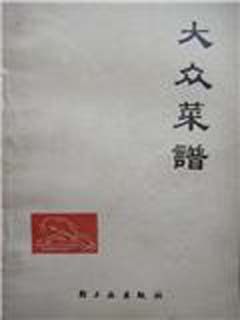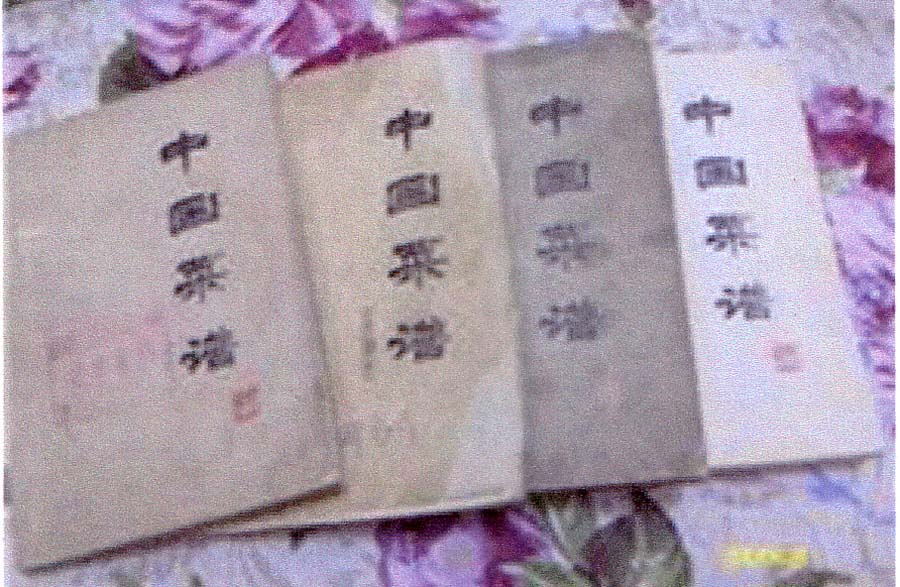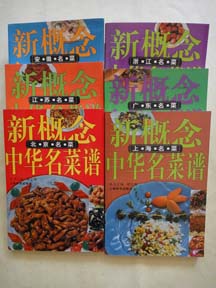
| What is Flavor and Fortune? |
| How do I subscribe? |
| How do I get past issues? |
| How do I advertise? |
| How do I contact the editor? |
Read 7002437 times
Connect me to:
| Home |
| Articles |
| Book reviews |
| Letters to the Editor |
| Newmans News and Notes |
| Recipes |
| Restaurant reviews |
| Article Index (all years, slow) |
| List of Article Years |
| Article Index (2024) |
| Article Index (last 2 years) |
| Things others say |
| Related Links |
| Log In... |
| Authors |
| Categories & Topics |
Recipe Culture Forum; A Report
| by Rongguang Zhao |
Conferences, Meetings, Announcements, and Reports
Summer Volume: 2011 Issue: 18(2) page(s): 16 - 18
The following, excepts are from a talk given by the author in Xian, China to help westerners increase understandings about what Chinese food was in the past and where it is going now. The author hopes these items he presented at this forum provide greater understanding about differences in Chinese and western perceptions about Chinese food. The report is:
That Chinese researchers sometimes, but not always, differentiate between shidan which some translate as a 'menu' or 'list of dishes,' and shipu which most often means a 'recipe' with names of ingredients and how to prepare the dish. At present, standardized usage of these and other food-related words are needed.
'Catering,' to the Chinese means all commercial cookery efforts. Therefore, this term has a different meaning than in the western world where it most often means restaurant or vendors preparing foods that can be sent to home or office, sold commercially, and/or used by others.
In China, shidan was first seen and popularized during the Tang Dynasty (618 - 907 CE). The use of shipu came later with names of ingredients and how they are prepared. In the western world these items are the 'ingredients' and the recipe's 'method' or 'preparation.'
In China, the earliest records of recipes include those of Fu Ming, a Mongolian scholar in the Qing Dynasty (1644 - 1911 CE). He said that throughout Chinese history, as food and music were totally unknown for centuries, one could not know people's tastes simply by reading Chou Rituals from 1046 - 771 BCE, the Qi Min Yao Shu from 533 -534 CE, or recipes written by folks in the Tang Dynasty (618 - 907 CE). Many early volumes are not clear, such as names of Kaifeng and Hangzhou foodstuffs found in the Dongjing Meng Hua Lu of 1147 CE.
 In earlier times, Chinese historical literature did record some but not all names of raw foods used. Rarely did they include how these were cooked. The historical documents had to wait for experts to see and report the essence, taste, and particulars of making these foods.
In earlier times, Chinese historical literature did record some but not all names of raw foods used. Rarely did they include how these were cooked. The historical documents had to wait for experts to see and report the essence, taste, and particulars of making these foods.
Based on my understanding and experimental research, many food records in Qi Min Yao Shu can be restored to their original state. In fact, I have successfully done an experiment of shuiyin noodles and suo noodles so that these items in Volumes Eight and Volume Nine of the Qi Min Yao Shu can be regarded as a complete shipu, albeit with interpretation generations later.
The world's most ancient recipes, found in Mesopotamia between the Tigris and Euphrates Rivers, carved on stone plates, are from about 1700 BCE. Archeologists tell us their cooking methods were for buffalo, antelope and pigeon stewed up into a soup. In pre-Qin classics, which were before 221 BCE, the earliest information found about Chinese recipes is not clear, nor are those in Chou Rituals or in Etiquette, both written before 221 BCE. In the Book of Rites, a chapter in the Nei Zei volume discusses foodstuffs, techniques, table manners and dietary principles. This book is written but a few centuries ago and details are still not clear.
A chapter of 'Original Flavor' in Lu Shih Chun Qiu of 239 BCE, is comprehensive documentation of dietary thinking, theory, and technique. The Sui Yuan Recipes written circa 1792 CE have the reputation of being an ancient Chinese food bible of shidan and shipu. This book does contain dietary knowledge, art, and technique and it represents the highest achievements in Chinese dietary culture. Though not that old, the recipes in it are not classic but rather general ones.
 Throughout Chinese history, menus and recipes are different. They require understanding and interpretation, as they were often written by intellectuals, not chefs because the chefs were illiterate. The backgrounds of the intellectuals often related to herbal medicine and/or agriculture. Chefs used experiences and memory to cook, their minds probably filled with recipes from Qi Min Yao Shu.
Throughout Chinese history, menus and recipes are different. They require understanding and interpretation, as they were often written by intellectuals, not chefs because the chefs were illiterate. The backgrounds of the intellectuals often related to herbal medicine and/or agriculture. Chefs used experiences and memory to cook, their minds probably filled with recipes from Qi Min Yao Shu.
Before the Song Dynasty (960 - 1280 CE), readers of recipes often were high officials; later, they were well-off officials and urban residents. It is only since the 20th century that common folk and professional chefs in China have been reading and using written recipes.
After the founding of New China and until 1966, very few recipe books were published. My investigation shows there were about ten kinds of books. Well-known ones were titled: Recipes of Famous Dishes in the Beijing Hotel (1955 CE), Recipes of Chinese Famous Dishes (1957 CE), Teaching Recipes (1957-1959 CE), Collection of Recipes (1960 CE), Training Recipes (1973 CE), and the Recipes of Cold Dishes (1973 CE).
In these times, there were no distinctions between household recipes and those used by professionals. In fact, most recipes were methods of dishes served in restaurants, written by government officials. Individual authorship was rare. One such was the Recipes of Famous Dishes in the Beijing Hotel, compiled by the hotel in 1955. Another was the Recipes of Chinese Famous Dishes compiled in 1957 by a city food service organization.
In the years between 1966 and 1978, the type and quantity of Chinese recipes do increase, the basic style simple text and no pictures. One of the most influential recipe books is Popular Recipes published in 1966, its picture is on this page. It has sold three hundred million copies to date. A few typical recipes, rewritten in Flavor and Fortune style appear at the end of this article.
Understanding contemporary Chinese food means looking at China's national conditions and using the three decades of 1978 - 2008 CE to describe food service. Some recipes reflect the culture and the economy, and to a certain extent varying aspects of China's social life. In these early days of reform and opening up, recipes were records of traditional cooking. Until the middle of 20th century, almost all Chinese cookbooks published in China were called 'recipe books,' and they had no pictures.
Traditional cooking did receive respect as did excellent chefs. Both were taken seriously. Traditional foods were popular in restaurants and in the oral history of many a famous chef. Tidbits about dinners at their eateries made them hot spots in China's food culture.
In that first decade after that period, that is from 1978 to 1988 CE, reading Chinese recipes such as those at the bottom of this page, had significance for restaurants and for the few families who frequented them. Their readers were chefs and ordinary people, all were cooking and eating enthusiasts. Compared to traditional chefs, these enthusiasts appreciated artistic dishes, however, the recipes they read were basic ones for daily diets as were those found in Popular Recipes. Printed in monochrome with some new volumes adding color, or as inserts, many young professionals did benefit when they used them.
During the first decade after reform, that is from 1978 to 1988 CE, to meet consumer demand, recipes were published in gourmet-type books. Chinese food service benefitted as did official and business consumers who paid the bills using public funds. Senior officials of the Chinese State Statistics Bureau advises that from 1978 to 2003, China's state revenue increased twenty-eight times, eating and drinking expenses rose from less than fifty to seven hundred billion yuan. Was this a special situation or political corruption?
In the second decade of reform from 1988 to 1998 CE, Chinese recipes changed from popular and simple to delicacies of every kind. They used lots of bird's nest, abalone, and shark's fin. Cookbooks became gourmet volumes. Note some of them shown with this article. In the last years of the 20th century following introduction of recipe copyrights from Hong Kong and Taiwan, Chinese recipe books gradually changed from monochrome and text only, to large-volume full-color printing with illustrations. They changed in another way, too, they began to call them cookbooks. They improved and kept up with popular trends in foods served to the public. They concentrated on practicality, readability, and visuals and they enticed people to add them to their bookshelves. They also added their foods to their personal experiences.
A new concept emerged in the third decade from 1998 to 2008 CE, that was the addition of cultural recipes. Perfection of recipes and cultural meanings became trendy. They reflected a chef's cultural level, occupational philosophy, aesthetics, and values. However, these recipes did not reflect the tastes of the masses. The New Concept of Famous Chinese Recipes written from 2004 to 2005 CE, are a cookbook series shown with this article that represent this trend. In addition to cultural items, these books provide autobiographical information about the authors, and they help the author's career and reputation.
Food service in China at the end of 20th century does see changes in restaurant consumption. More and higher wage-earners are now paying for their own food. There is interest in food science and food security. People look to green, environmentally safe foods including native chickens and farmhouse dishes. Cookbooks during this time show China becoming a green safe gourmet paradise, cookbook authors use words to accomplish this green revolution, and they promise food security. But, is it real?
Other popular trends include high-grade restaurants making daily menus into fancy painted albums. From dishware to taste, restaurants express every aspect of their food and service vividly. Many famous ones introduce foods their now famous chefs serve, but many of these dishes are not cooked by the chefs themselves. In addition, they feature more foodstuffs such as bird's nest, abalone, shark fin, and ginseng, though few customers order these expensive items.
 Recipes and cookbooks play important roles in the training of chefs; even fast food has impact that changes traditional recipes and people's tastes. Food sanitation, safety, and freshness go from being the privilege of a small number of the wealthy to greater numbers among the masses. Seeing cookbooks from Hong Kong and Taiwan with style, professional typesetting and printing, current and colorful camera technology, and modern cooking methods have positive effects on cookbooks published in China. Five words illustrate this indicating these cookbooks are: Beautiful, Available, Vivid, Educational, and Sensible. The impact of these books and others from Japan and South Korea are extensive. Some influences from America show interest in less quantity and more light and fresh foods, fancier tableware, and dishes beautifully decorated. These impacts Chinese foods in homes and in restaurants. Now, many upper class families enjoy and appreciate delicious foods with friends at home and in restaurants. According to personal observations, many families have cookbooks, some middle-class families can have thirty of them. Rich people have a tradition of chasing delicious foods, and they are now get illustrated recipes enabling them to make or order these upscale foods.
Recipes and cookbooks play important roles in the training of chefs; even fast food has impact that changes traditional recipes and people's tastes. Food sanitation, safety, and freshness go from being the privilege of a small number of the wealthy to greater numbers among the masses. Seeing cookbooks from Hong Kong and Taiwan with style, professional typesetting and printing, current and colorful camera technology, and modern cooking methods have positive effects on cookbooks published in China. Five words illustrate this indicating these cookbooks are: Beautiful, Available, Vivid, Educational, and Sensible. The impact of these books and others from Japan and South Korea are extensive. Some influences from America show interest in less quantity and more light and fresh foods, fancier tableware, and dishes beautifully decorated. These impacts Chinese foods in homes and in restaurants. Now, many upper class families enjoy and appreciate delicious foods with friends at home and in restaurants. According to personal observations, many families have cookbooks, some middle-class families can have thirty of them. Rich people have a tradition of chasing delicious foods, and they are now get illustrated recipes enabling them to make or order these upscale foods.
These current impacts of shidan and shipu show many advances since the first recipe books are published in China. People are now incorporating their ideas into their lives.
_____
Zhao Ronggong is a professor at the Chinese Dietary Culture Institute at Zhejiang Gongshang University in Hangzhou, in the Zhejiang Province of China
| Fried Rape, Beijing Style |
|---|
1 pound rape 1 teaspoon lard 1/4 teaspoon ginger, smashed 1/2 teaspoon cooking oil 1/2 teaspoon soy sauce 1/4 teaspoon salt Preparation: 1. Clean rape and cut this vegetable into one-inch pieces and set aside. Cut the lard into small pieces. 2. Heat a wok or fry pan and when hot, add lard and then the rape. Fry this until eighty present done, then add bruised ginger, soy sauce, and salt. Stir-fry for three to five minutes, then serve. |
| Shrimp-sauced Spinach, Shanghai Style |
|---|
1 pound spinach 1/10 pound bamboo shoots 1 teaspoon lard 1/2 teaspoon shrimp sauce 1/4 teaspoon salt 1/4 teaspoon monosodium glutamate (optional) Preparation: 1. Wash spinach and cut into one and a half- inch pieces. Also, cut bamboo shoots into small pieces. 2. Use a wok or fry pan, add lard, and just as it begins to smoke, add spinach and bamboo shoots. If the juice of the spinach is not enough, add some soup-stock. 3. Stir-fry until spinach is deep green and shiny, add the shrimp sauce, salt, and monosodium glutamate, if using it; then serve. |
| Braised Pork, Guangzhou Style |
|---|
1 pound streaky pork 1/2 teaspoon soy sauce 1 teaspoon cooking oil 2/3 pound of arrowroot (or taro) 1 teaspoon preserved beancurd, mashed 1/2 teaspoon mashed garlic 1/2 teaspoon cooking wine 1/4 teaspoon ground star anise 1/2 teaspoon sugar 1/2 teaspoon cornstarch 1/2 pound of green vegetables Preparation: 1. Clean the streaky pork and boil it in an earthen pot in hot water until seventy percent cooked. Then add the soy sauce. 2. Heat a wok or frypan, add the cooking oil, and then the pork stirring this until the color of its surface turns scarlet. Then put the pork into cold water, and when it is cold, cut it into many oblong-shaped pieces. 3. Peel and clean the arrowroots then boil them in hot water until tender, then cut them into oblong-shaped pieces matching the pork pieces. 4. Put pork in a bowl with the mixture of preserved beancurd, mashed garlic, cooking wine, ground star anise, and sugar. 5. Put each piece of pork with a piece of arrowroot with its skin down into a bowl, then steam over boiling water for forty minutes. 6. Boil vegetables until bright green, strain and put them under the bowl, and top with the pork and arrowroot carefully turned over onto the greens. Mix a tablespoon of cool water or cooled vegetable liquid with the cornstarch and pour over the pork. Then serve. |

Copyright © 1994-2024 by ISACC, all rights reserved
Address
3 Jefferson Ferry Drive
S. Setauket NY 11720